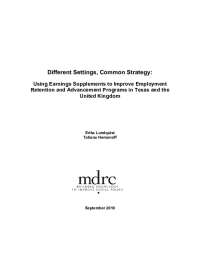Different Settings, Common Strategy
Using Earnings Supplements to Improve Employment Retention and Advancement Programs in Texas and the United Kingdom
When the U.S. Employment Retention and Advancement (ERA) evaluation began in 1999, much more was known about how to help welfare recipients and other low-income individuals prepare for and find jobs than about how to help them stay employed and advance. The U.S. and UK ERA projects, which both used a random assignment design to compare outcomes for program and control groups, sought to fill this knowledge gap. The Texas sites in the U.S. project and the UK program chose to test similar strategies to help current and former welfare recipients maintain and advance in jobs, offering them postemployment work-related services combined with earnings supplements, or stipends.
Participation in the UK ERA program was voluntary, while participation in preemployment services in the Texas ERA program was mandatory, as a condition of Temporary Assistance for Needy Families (TANF) receipt. Members of the program groups in both programs were eligible to receive stipends if they worked full time for a certain length of time (differing by program) and met additional requirements that varied by program — notably, in Texas, the requirement to take part in monthly activities meant to increase employability or earnings. Unlike most other tested interventions aimed at employment retention and advancement, the UK program and the Corpus Christi and Fort Worth sites in the Texas program produced gains in employment and earnings. The fact that earnings supplements were part of programs that had positive effects in two such different locales suggests that they may travel well — and this potential adaptability is one reason to examine patterns of how these benefits were structured and received. This paper, which provides such an analysis, shows that:
- Overall, the proportions of program group members who received stipends were similar for the Texas and UK programs: 20 to 29 percent of participants over a two-year follow-up period.
- A total of 82 to 85 percent of UK participants and 50 to 65 percent of Texas participants who were estimated to have met the employment eligibility criteria for stipends received them. This suggests that other programs that use stipends may be able to boost receipt rates for participants who meet employment conditions by minimizing supplemental requirements. But because such requirements may have positive effects on employment and earnings, the expected gains from eliminating them should be weighed against their potential benefits.
- Interviews with a small number of Texas ERA participants indicated that some people did not know about the stipends or did not understand their eligibility criteria. This suggests that more concerted efforts to explain and market stipends could boost receipt rates over the levels achieved in the Texas sites.
- All other factors being equal, programs where people are volunteering to receive help finding employment, as in the UK ERA program, may achieve higher stipend receipt rates than programs where people are required to participate in job-finding activities, as in the Texas ERA program. This does not necessarily mean that earnings supplements are more effective in voluntary programs; indeed, earnings supplements may be more likely to function as windfalls in voluntary programs.
The paper’s examination of the structures and implementation of the stipends and their take-up rates adds to information about a strategy that, unlike most others used to help low-income workers keep jobs and advance, has often been effective. The findings suggest that it would be valuable to operate future experiments testing varying combinations of stipends and services in one location to allow fuller conclusions about the combinations of these two strategies that work best.






